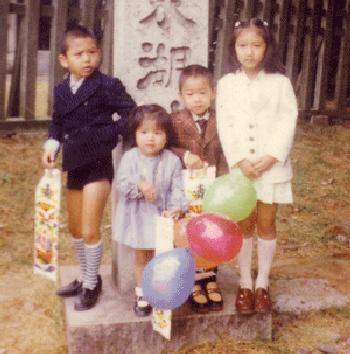
Sichi-go-san: Costumes

Figure 1.-- Children commonly dress up in traditional costumes for Shichigosan. Some children rather than tradutional costumes wear their best suits and dresses. The family here looks to have been photographed in the 1880s. Note the candy sacks. We are not sure why some parents stress up the children in Western clothes rather than traditional outfits, but believe that the traditional clothes have become much more popular.
|
Costuming is an important part of Sichigosan. Children commonly dress up for Shichigosan. Young children love to dress up in costumes. Even boys at these ages enjoy it. Many children are dressed upin tradotional costumes. Some childre wear their best western-style suits and dresses. The girls might dress in brilliantly colored kimono and the boys in elaborate pleated skirts known as hakama. For the girl, age 3 marked the age that her hair will be put up in an adult-like manner for the first time. When she reaches age 7, she is given her first obi, the silk sash to be worn with kimono. For the boys, 5-year old is the age they are given their first hakama. We are not sure why some parents sress up the children in Western clothes rather than traditional outfits, but believe that the traditional clothes have become much more popular.
HBC

Navigate the Boys' Historical Clothing Web Site:
[Introduction]
[Activities]
[Biographies]
[Chronology]
[Clothing styles]
[Countries]
[Bibliographies]
[Contributions]
[FAQs]
[Glossary]
[Satellite sites]
[Tools]
[Boys' Clothing Home]
Navigate the Boys' Historical Clothing Japanese pages:
[Return to the Main Sichigosan page]
[Return to the Main Japanese folk costume holiday page]
[Return to the Main Japanese holiday page]
[Choirs]
[Department store catalogs]
[Monarchy]
[Music recitals]
[Scouts]
[School uniforms]
Created: 4:32 PM 10/11/2006
Last updated: 4:32 PM 10/11/2006



